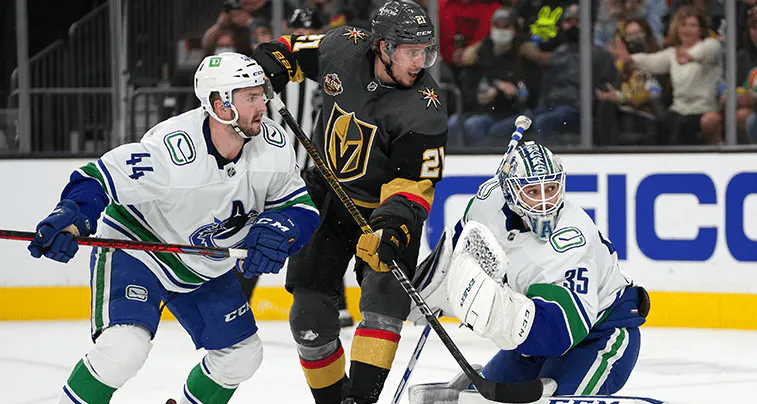McKenna: A nuanced take on Thatcher Demko’s delay-of-game penalty

By: Mike McKenna
At 7:03 of the third period in Saturday night’s game between the Vancouver Canucks and Vegas Golden Knights, NHL referee Chris Schlenker assessed a two-minute minor penalty for delay of game on Canucks goaltender Thatcher Demko.
It was a brutal call.
I can tell you from personal experience that – unequivocally – Thatcher Demko did not push the net off on purpose. He went into a routine RVH post-integration – a technique that’s used dozens of times during the course of a game – and the pegs holding the net in place failed.
Look at Demko’s reaction to the call. He’s incensed and pleading with referee Chris Schlenker to rescind the penalty.
I’ve been in his skates and my blood would boil every time I was penalized. Not only was my team being put a man down, the referee was essentially deeming me a cheater. However, it wasn’t my fault the net and pegs failed. I was simply doing my job. When the referee would refuse to believe my argument that it wasn’t intentional, the sting only grew worse.
As a goaltender, it burns your soul. These penalties make us look like liars. The public buys in and it fuels the narrative that goalies just go around pushing the net off whenever they feel like it. When in reality, probably 95 percent of the time, that’s not the case.
NHL nets are anchored into the concrete below the ice surface using standardized rubber pegs that extend upward into the goal frame. The net has to be pushed vertically to be knocked off – when the pegs are properly installed. It’s not as easy as it looks.
As you can see from the overhead replay, Demko is only putting lateral pressure on the post when he enters into RVH. His back leg is driving his body against the red iron, creating a puck-resistant seal on the short side. It’s routine. Goalies do it regularly without incident. But in this case, the net came off immediately.
Why? Less than two minutes before the penalty was assessed on Demko, Golden Knights forward Keegan Kolesar crashed the crease and knocked the net loose. And I believe it wasn’t put back in place properly.
See how much force it takes to knock the net off? It’s not a light tap. Kolesar is well over 200 pounds and he’s slammed into the cage by a backchecking J.T. Miller. He hits the net hard enough that it’s forced upward. The rubber pegs bend and are eventually overwhelmed with pressure, causing them to release.
Compare Kolesar’s net contact with Demko’s and the difference is striking. It’s like comparing a gas-powered leaf blower to one of those handheld fans you buy at the convenience store. It’s not even remotely close.
How did the net come off so easily for Demko? Watch the video of Kolesar driving the net and take notice of linesman Kyle Flemington at the very end of the clip. He grabs the net and starts to move it back into position.
Now, I can’t see what happens after. But I have a really good guess – because it happened countless times during my career.
Flemington either slid the net back into place and let the pegs drop down into the concrete, or he replaced the pegs, then set the net back on them. Sometimes that’s good enough. But quite often, the pegs don’t end up fully inserted into the concrete, and the net becomes unstable.
A goaltender can feel that immediately. The first time you transition into RVH and put pressure against the post, it feels loose. It always made me nervous: do I lean hard into the post like normal, even if it risks the net coming loose? Or did I play it cautiously and potentially lose my technique and power? Either way it felt like I was making a losing decision.
In this case, I don’t think the net was fully anchored. The moment Demko made contact with his skate blade against the post, it failed. It shouldn’t have been that easy.
So how can the NHL prevent these situations?
I think it’s easy. Don’t let the on-ice officials put the nets back on. Simple as that. I think a rink attendant needs to be on skates at all times prepared to go out on the ice and make sure the net is properly anchored.
Will this slow the game down? Not if they’re prepared. Opening the Zamboni gate takes seconds. Skating the length of the ice and back takes less than a minute. Bring out the cordless drill with the speed bit. Have a small shop vac ready to remove snow and water from the hole. Do whatever is necessary to make sure the nets stay put.
Officials shouldn’t have to worry about replacing nets. They’ve got more important things on their plate during the course of an NHL game. Let the professional rink crew handle it.
This entire scenario was avoidable. Chris Schlenker looks bad. Thatcher Demko looks bad. Kyle Flemington looks bad. When in reality, all of them are just trying to do their job. Hopefully the NHL takes notice and puts protocol in place to keep it from happening again.
More from Mike McKenna
- Ranking every NHL goalie tandem for 2023-24
- Staring down Lou: How standing up for yourself can change a player’s career
- Why it’s time to embrace ‘gambles’ like the Jake Sanderson contract
- Why we shouldn’t view Sheldon Keefe’s contract extension as a vote of confidence
- ‘Two Sean O’Connors?’ NHL training camps bring the funny – and the weird